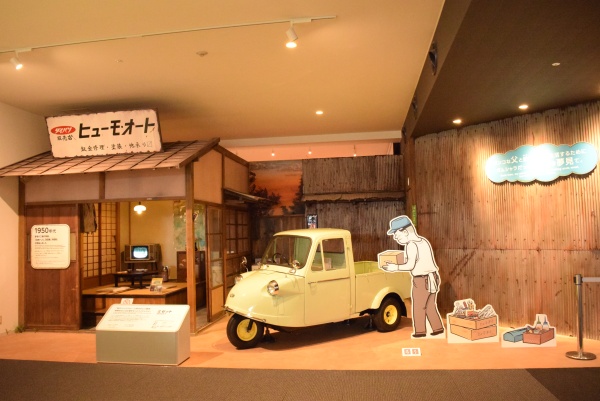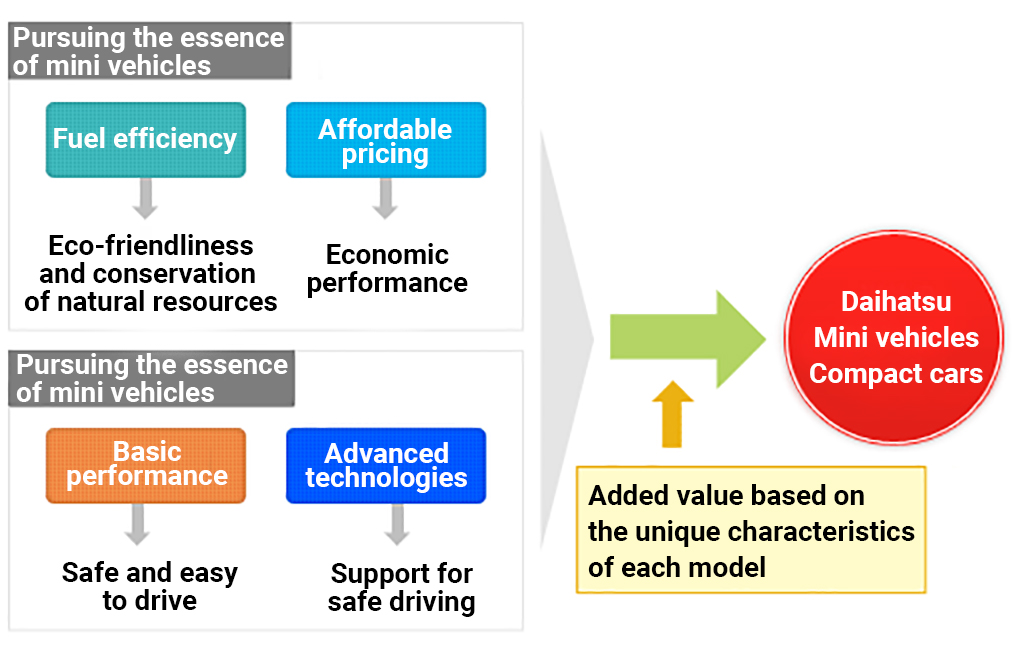Mini Vehicles and Daihatsu
The birth of the mini vehicles

Mini vehicles were created during the 1950s, when automobiles were luxury products, with the aim of producing “one car for each home.” Various manufacturers introduced affordably priced mini vehicles that were easy to drive even on narrow roads and these cars became widely used.
Mini vehicles today
Cars are widely used in present-day Japan. Mini vehicles make use of their unique advantages to contribute to society in a variety of ways.
Qualities unique to small-size cars

According to the Regulations for Enforcement of the Road Transport Vehicle Law (revision of October 1998), mini vehicles must meet the following conditions:
- Total length of 3.4m or less; total width of 1.48m or less; total height of 2.0m or less
- Displacement of 660cc or less
- Seating capacity of 4 persons or less
- Cargo capacity of 350kg or less
1.Mini vehicles in rural areas
Tokyo and other urban areas have mature railroad networks, and for this reason an increasing number of residents choose not to own cars. In rural areas, on the other hand, the majority of residents feel cars are essential for traveling to work or to school; indeed, rather than “one car per family,” in rural areas “one car per person” is considered desirable. Consequently, mini vehicles are extremely popular, both because they take up less space and because they are more economical than larger vehicles.
2.Mini vehicles and the environment

Taking advantage of their low weight, mini vehicles have long been known for their fuel efficiency, and for their low gasoline costs. In recent years, in addition to their superior economic performance, attention has focused on their environmental performance and effectiveness in reducing CO2 emissions.
3.Mini vehicles meet the demands of Japanese customers

Affordably priced, fuel efficient, and with a small and easy-to-maneuver body, mini vehicles have continued to evolve thus far. Japan boasts a mature automotive industry, and it is therefore necessary to cater to various customer demands. Developing active safety technologies, improving ride comfort, and adopting diverse designs— mini vehicles will continue to evolve to the meet the needs of Japanese customers.
Mini vehicles and Daihatsu

Mini vehicles are products unique to Japan, and are made specifically for Japanese customers.
However, thanks to its development of Mini vehicles in Japan, Daihatsu also possesses expertise in creating compact cars that can be applied overseas.
By applying its experience of developing mini vehicles in Japan to the production of cars in Indonesia and Malaysia, Daihatsu not only delivers cars that are welcomed by customers in these two countries—it also contributes to the growth of their automobile industries.
In this way, Daihatsu is using its Japanese mini vehicles to drive the expansion of its business overseas: “Aiming to be the best in Japan will help us be the best in other countries as well.”